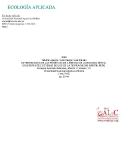Determinación de las reservas de carbono de la biomasa aérea, en diferentes sistemas de uso de la tierra en San Martín, Perú
Alternative title
Determination of carbon reserves of the aerial biomass in different land use systems in San Martin, Peru
Description
11 páginas: 10 ilustraciones, 1 tabla. 8 referencias bibliográficas Documento con resumen en español e inglés.
Résumé
Se determinó la biomasa aérea en diferentes sistemas de uso de la tierra en la región de San Martín-Perú, con la finalidad de conocer el potencial de captura de carbono. Los sistemas de uso de la tierra evaluados fueron: Bosque primario, Bosque secundario de diferentes edades, sistemas agrícolas locales maíz (Zea maiz), arroz (Oriza Sativa), pastos (Brachiaria) y sistemas agroforestales con café (Coffea arabica) bajo sombra y cacao (Cacao sp.). También se comparó este potencial con otros sistemas de uso de la tierra de otras regiones del Perú y se monitoreó la pérdida de reservas de carbono después del corte de la foresta y su reemplazo por cultivos. En cada uno de éstos sistemas se establecieron al azar cinco transectos donde se evaluó la biomasa arbórea. Dentro de éstos transectos se establecieron cuadrados también al azar para cuantificar la biomasa herbácea y la biomasa de hojarasca. El carbono total en el bosque primario fue de 485 tm C ha-1, superando ampliamente las reservas del bosque secundario de 50 años y de bosque descremado de 20 años. Con relación al bosque primario se observa una reducción de reservas en más de 50% del bosque secundario de 50 años (234 tm C ha-1). El bosque descremado de 20 años perdió más del 80% de reservas (62 tm C ha-1). El nivel de reservas de carbono en la biomasa de hojarasca de los sistemas boscosos, no es significativo al compararlo con el total de las reservas de carbono de la biomasa aérea; sin embargo si es significativo para sistemas agroforestales. Los sistemas agroforestales secuestraron entre 19 a 47 tm C ha-1, dependiendo de la cantidad de especies forestales, tipo de cultivo, edad y tipo de suelo y recuperan el potencial de captura en forma productiva. Los sistemas agrícolas capturaron poco C (5 tm C ha-1), además generan fugas de gases efecto invernadero (GEI) cuando se usan agroquímicos y quema de rastrojos, entre otros. Carbon (C) reserves of the aerial biomass were determined, to evaluate the potential of C captures in different land uses in the region of, San Martin, Perú. The land use systems (LUS) were: Primary forest, secondary forest of different ages, traditional agricultural maize systems (Zea maiz), rice (Oriza Sativa), pastures (Brachiaria) and coffee agroforestry systems (Coffea arabica) under shade and cocoa (Cacao sp.) also under shade. These LUS were compared with other LUS of other regions of Perú and the loss of C reserves were monitored after land clearing of the forest for cropping. Five random transects for each land use system and within each of these transects; tree and herbaceous biomass and litter biomass were monitored. Total C in primary forest was 485 tm C ha-1, much higher than the carbon reserves of the 50 years secondary forest (234 tm C ha-1 which is 50% lost ) and the 20 years logged forest (60 485 tm C ha-1 which is 80% lost). The level of C reserves in the biomass litter of the wooded systems is not significant when compared with the total of the C reserves of the aerial biomass; nevertheless it is significant for agroforestry systems. The agroforestry systems sequestered between 19 a 47 tm C ha-1 and varied in tree species, type and age of crop, soil class and recovered the C capture potential in a productive way. The cropping systems sequestered low levels of C (5 tm C ha-1) and generated greenhouse gas emissions (GGE) when burning or over use of agrochemicals or other inputs, are imployed.
Keywords
ZEA MAYS, ORYZA SATIVA, BRACHIARIA, COFFEA ARABICA, BIOMASA, UTILIZACION DE LA TIERRA, SECUESTRO DE CARBONO, ALMACENAMIENTO DE CARBONO, BOSQUES, AGROFORESTERIA, ARBOLES FORESTALES, ARBUSTOS HOJARASCA, PERDIDAS, MEDICION ALOMETRIA, ECUACIONES ALOMETRICAS, BIOMASA AEREA, BIOMASS, CARBON, STORAGE, FOREST TREES, SHRUBS, MEASUREMENT, FORESTS, LAND USE, AGROFORESTRY, PERU,
Éditeur
CATIE, Turrialba (Costa Rica)
Collections
- Publicaciones y documentos [3648]


